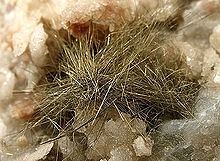Acicular (crystal habit)

Acicular, in
crystals
. Crystals with this habit tend to be fragile. Complete, undamaged acicular specimens are uncommon.

The term "acicular" derives from the Late Latin "acicula" meaning "little needle".[1] Strictly speaking, the word refers to a growth habit that is slender and tapering to a point. Prismatic crystals are not acicular; however, colloquial usage has altered the commonly understood meaning of the word. When writing for mineralogical publications, authors should restrict their usage of "acicular" to crystals with the tapering growth habit.
To add to the confusion, some minerals are described with various morphological terms. For example, natrolite is often described as slender prismatic and millerite is often described as filiform or capillary.
Examples
dimethyltryptamine have an acicular habit,[3] but this substance is not regarded as a mineral by the International Mineralogical Association. An acicular phase of steel is bainite
.
Differences from other habits
Some minerals like
fibrous
crystals in their thickness; crystals with a fibrous habit are much thinner, sometimes to the point of being flexible like hair, while acicular crystals are thicker and rigid.
See also
References
- ^ "Definition of Acicular". Merriam-Webster Dictionary. Merriam-Webster. Retrieved 9 March 2016.
- ^ Hamilton, W.R. et al. (1974) The Hamlyn Guide to Minerals, Rocks and Fossils, London, Hamlyn, page 9.
- ^ Bergin, Rolph. et al. (1968) Preliminary X-ray Crystallographic study of some psychoactive indole bases, Stockholm, Karolinska Institutet, page 1
External links
Wikimedia Commons has media related to Acicular (mineral habit).
- "Skeletal microstructure of Galaxea fascicularis exsert septa: a high-resolution SEM study", Biological Bulletin
